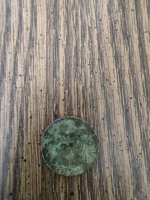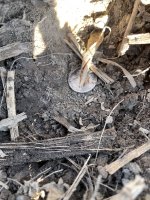veryoldrockhunter
Greenie
- Jan 28, 2012
- 18
- 0
- Primary Interest:
- Other
You know, I feel quite certain that there was a time when there was a man--maybe Homo Erectus or possibly an early Homo Sapien that
decided to design an arrowhead.
_________________________________________________
I as an electronic design engineer and electronic technician have been given design criteria in a form such as this:
The enclosure shall be as follows:
1.) It shall be made of 6061 aluminum.
2.) It shall be grained and anodized
3.) It shall have rounded corners.
4.) It shall have front handles.
1.) The printed circuit board shall be of G-10 military grade epoxy copper-clad board of .062 thickness.
2.) The board shall be of no more than 4 layers
3.) The board shall be silkscreened with a ledgend of the components to be attached to it.
4.) The board shall be tin-lead plated
5.) The tin-lead shall be oil-heated and flowed.
6.) The board shall be hand-soldered
etc, etc, etc! I think that you should get the picture!
Now when this Early Man decided to design the very first arrowhead, I just know that he first hunted up something to scribble on and
layed out the design criteria for his new invention. I'm sure that it went something like this:
1.) This pointed device shall be of complete symetri.
2.) The thickness shall be heaviest in the center and gradually come out to each edge
in a very equal manner so as to be the same thickness at all points at the place that constitutes the edge.
3.) The top half of the device shall be an identical mirror image of the bottom half! Like-wise, the back side shall be an identical mirror image of the front side!
4.) The device shall be balanced perfectly so as to not wobble as it flys to it's destined target.
5.) Also The Arrow shaft shall be perfectly round!
6.) The Arrow shaft shall have an exact straightness for a like reason!
7.) There shall be a counter-balance device on the end adjacent to the arrowhead device for balance of the total shaft. It should be made
out of the finest eagle feathers for trueness.
You can bet your life on it--if it could be proven--that is exactly how the arrowhead
was invented!
So what is my point? Why did I type this up as early as my 2nd post on this forum?
Because, I have been trying to find others that understand that arrowheads did NOT start out as an artistic collectable item from the git-go. They had to go through the process of evolving into the beautiful pieces we find today and charish as art. We can also be sure that the first arrowheads were tied to the side of the shaft. eventially the man using them decided that the arrows would trael in a much smoother fashion if the arrowhead was in the center of the tip instead of on the side. Then one day he got to thinking that it would be better if it were thinner and thinner and thinner and thinner--you see evolving over a period of time into the beautiful items that work so well.
I would like to communicate with others that have the same understanding as I do in this area.
I found a "rock" back about 8 years ago when I first got started into the hobby of hunding arrowheads and I was positive that it was truley a point or tool of some kind but everyone that I was with on this outing declared it to be nothing more than a rock. Well, I can get very stubborn when I am sure of myself. I was VERY sure! I kept hunting in the area that I found the first piece of this type and found 3 more identical to it within the next few days.
Over the years, I have collected rocks of the exact shape--which by the way was--kind of weird. Now, I have also found the exact same shape made from jasper which were smooth, or ragged but I have also found the exact same shape and knapped from flint. I have also NOW found them in the books. They are usually called Spoke-Shaves and most of the ones in the books come from Islands off the coast of Alaska. Mine were found in Arkansas, NC, California, and OK.
Also, I now have about 75 of these pieces that any person of sane mind would recognize as being definitely related. I am sure of at least one thing--that is that they are all at least cousins--and not very distant--LOL!
I guess one of the main things that I feel is that I would rather hold in my hand a piece of stone that was fashioned into a usuable tool over 1/2 a million years ago as to hold something made by a Native American in 1835. And I am Native American so I don't mean it as a predjudiced situation.
Have any of you have had similar ideas or found unusual items that you are sure of that no one is inerested in--I AM!
Thanks,
Billy Dean Ward
decided to design an arrowhead.
_________________________________________________
I as an electronic design engineer and electronic technician have been given design criteria in a form such as this:
The enclosure shall be as follows:
1.) It shall be made of 6061 aluminum.
2.) It shall be grained and anodized
3.) It shall have rounded corners.
4.) It shall have front handles.
1.) The printed circuit board shall be of G-10 military grade epoxy copper-clad board of .062 thickness.
2.) The board shall be of no more than 4 layers
3.) The board shall be silkscreened with a ledgend of the components to be attached to it.
4.) The board shall be tin-lead plated
5.) The tin-lead shall be oil-heated and flowed.
6.) The board shall be hand-soldered
etc, etc, etc! I think that you should get the picture!
Now when this Early Man decided to design the very first arrowhead, I just know that he first hunted up something to scribble on and
layed out the design criteria for his new invention. I'm sure that it went something like this:
1.) This pointed device shall be of complete symetri.
2.) The thickness shall be heaviest in the center and gradually come out to each edge
in a very equal manner so as to be the same thickness at all points at the place that constitutes the edge.
3.) The top half of the device shall be an identical mirror image of the bottom half! Like-wise, the back side shall be an identical mirror image of the front side!
4.) The device shall be balanced perfectly so as to not wobble as it flys to it's destined target.
5.) Also The Arrow shaft shall be perfectly round!
6.) The Arrow shaft shall have an exact straightness for a like reason!
7.) There shall be a counter-balance device on the end adjacent to the arrowhead device for balance of the total shaft. It should be made
out of the finest eagle feathers for trueness.
NOW--WHAT DO YOU THINK REALLY HAPPENED?
Here is what I think happened! a man about to fall asleep suddenly said to himself in what ever way he did his thinking about life,
"Pointed rock be better than pointed stick"!
You can bet your life on it--if it could be proven--that is exactly how the arrowhead
was invented!
So what is my point? Why did I type this up as early as my 2nd post on this forum?
Because, I have been trying to find others that understand that arrowheads did NOT start out as an artistic collectable item from the git-go. They had to go through the process of evolving into the beautiful pieces we find today and charish as art. We can also be sure that the first arrowheads were tied to the side of the shaft. eventially the man using them decided that the arrows would trael in a much smoother fashion if the arrowhead was in the center of the tip instead of on the side. Then one day he got to thinking that it would be better if it were thinner and thinner and thinner and thinner--you see evolving over a period of time into the beautiful items that work so well.
I would like to communicate with others that have the same understanding as I do in this area.
I found a "rock" back about 8 years ago when I first got started into the hobby of hunding arrowheads and I was positive that it was truley a point or tool of some kind but everyone that I was with on this outing declared it to be nothing more than a rock. Well, I can get very stubborn when I am sure of myself. I was VERY sure! I kept hunting in the area that I found the first piece of this type and found 3 more identical to it within the next few days.
Over the years, I have collected rocks of the exact shape--which by the way was--kind of weird. Now, I have also found the exact same shape made from jasper which were smooth, or ragged but I have also found the exact same shape and knapped from flint. I have also NOW found them in the books. They are usually called Spoke-Shaves and most of the ones in the books come from Islands off the coast of Alaska. Mine were found in Arkansas, NC, California, and OK.
Also, I now have about 75 of these pieces that any person of sane mind would recognize as being definitely related. I am sure of at least one thing--that is that they are all at least cousins--and not very distant--LOL!
I guess one of the main things that I feel is that I would rather hold in my hand a piece of stone that was fashioned into a usuable tool over 1/2 a million years ago as to hold something made by a Native American in 1835. And I am Native American so I don't mean it as a predjudiced situation.
Have any of you have had similar ideas or found unusual items that you are sure of that no one is inerested in--I AM!
Thanks,
Billy Dean Ward





